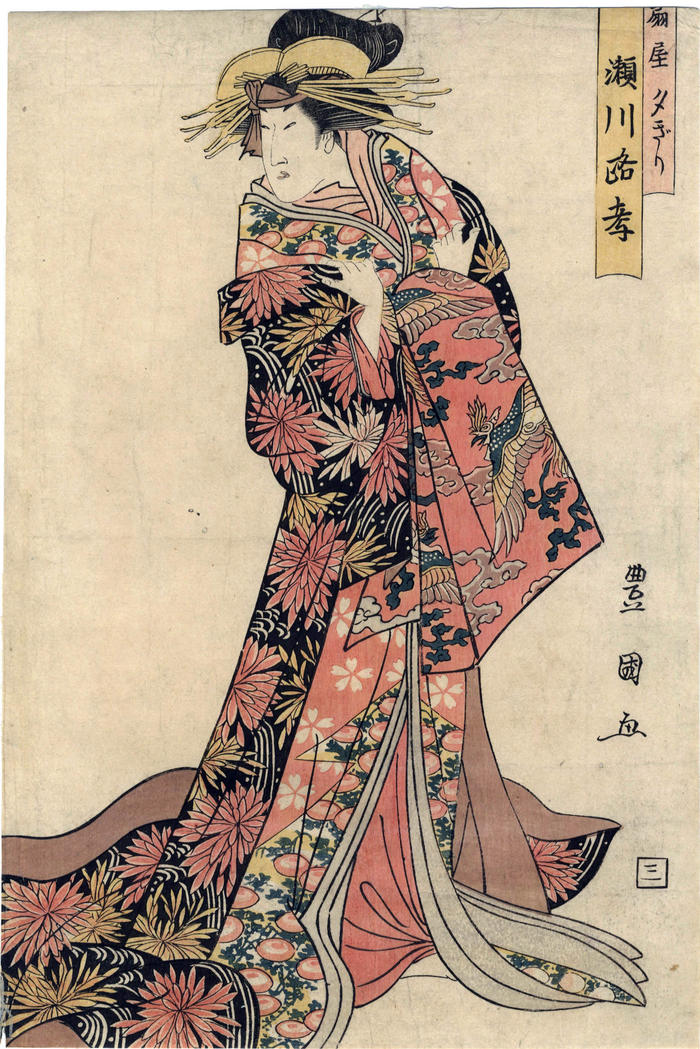Utagawa Toyokuni I (初代歌川豊国) (artist 1769 – 02/24/1825)
Segawa Rokō III (瀬川路考) as the courtesan Yūgiri (夕きり) of the Ōgiya house in the play Tayū Shibaraku Yukari no Tsukimi (太夫暫由縁月視)
08/1805
9.25 in x 13.75 in (Overall dimensions) Japanese color woodblock print
Signed: Toyokuni ga (豊国画)
Publisher: According to Marks 328, seal 16-011 is Mikawaya Seiemon, elsewhere it is Shimizu
Museum of Fine Arts, Boston
Mead Art Museum Yūgiri was a real person who attained the highest level among the courtesans, the tayū, a rank above an oiran. Although she died young at 22 her impact was felt strongly through Japanese culture via literature, bunraku and kabuki. Even Ihara Saikaku was said to have met her and wrote about her in 1684.
"Early in 1678, just after Yūgiri died, Sakata Tōjūirō, the famous Kyoto Kabuki actor and master in lover roles (wagoto), came to Osaka to perform at the Kaneko Rokuemon Theatre, in the play Farewell to Yūgiri at New Year (Yūgiri nagori no shōgatsu). He played opposite the star female impersonator Itō Kodayū II in the part of Yūgiri. Tōjūirō, as Izaemon the effeminate lover, was a great hit, giving birth to the famous theatrical pair Yūgiri-Izaemon. The play was such a success that it was repeated several times during that year. Each time, over the eighteen different performances during his lifetime, Tōjūirō added or altered elements to the Yūgiri-Izaemon love story; through Tōjūirō's acting, the Yūgiri plays became an indispensible part of the Kabuki repertoire."
Quoted from: 18th Century Japan: Culture and Society by C. Andrew Gerstle, p. 12.
Yūgiri's death memorialization in kabuki did not go unnoticed "...by the Jōruri world. Chikamatsu Monzaemon wrote the first one , Memorial to Yūgiri (Yūgiri Sanzesō, 1686), putting it into the typical plot of the oiesōdō (disturbance in a grand house) genre, the 'Yoshidaya' act being the most famous. The work, which became the basis for later Yūgiri plays is, however, Chikamatsu's, Yūgiri and the Straits of Naruto (Yūgiri Awa no Naruto, 1712). The 'Yoshidaya' act again was later rewritten for Kabuki as Letter from the Pleasure Quarter (Kuruwa bunshō), the version known to audiences today, first performed at the Edo Nakamura Theatre in 1808." Ibid., pp. 12-13.
****
The National Theater of Japan gave a good summary of the main male character in the play Kuruwa Bunsho or 'Letters to the Red-light District': "Izaemon is the young master of a wealthy merchant family, but has been disinherited by his parents because he is always visiting his courtesan lover. Having fallen into poverty, he visits his lover but becomes jealous and sulks when she is serving another customer. He is a likeable, somewhat winsome man with gentle features. Izaemon was created by Sakata Tojuro I, who worked in Osaka, and is a quintessential wagoto (soft) style character with a gentle manner who indulges in sensual love."
****
There is also another copy of this print in the Rijksmuseum voor Volkenkunde, Leiden.
****
The real Yūgiri of the Ōgiya (1654-78) was the toast of the town in Osaka. Then when that brothel relocated to Kyoto thousands of onlookers lined the route just to see her. She died at an early age from an illness. Chikamatsu Monzaemon's 1712 play, 'Awa no Naruto' helped to immortalize her especially her monologue about the life of a courtesan, true love vs. infidelity. But it should also be noted that there had already been numerous plays about this courtesans by the end of the 17th century.
Mikawaya Seiemon (三河屋清右衛門) (publisher)
actor prints (yakusha-e - 役者絵) (genre)
Segawa Rokō III (三代目瀬川路考) (actor)
Yūgiri (夕霧) (role)
Chikamatsu Monzaemon (近松門左衛門) (author)
Kabuki (歌舞伎) theater terms (genre)
